2019英语名词作状语的结构及其用法语文
高中英语--名词及其短语作状语
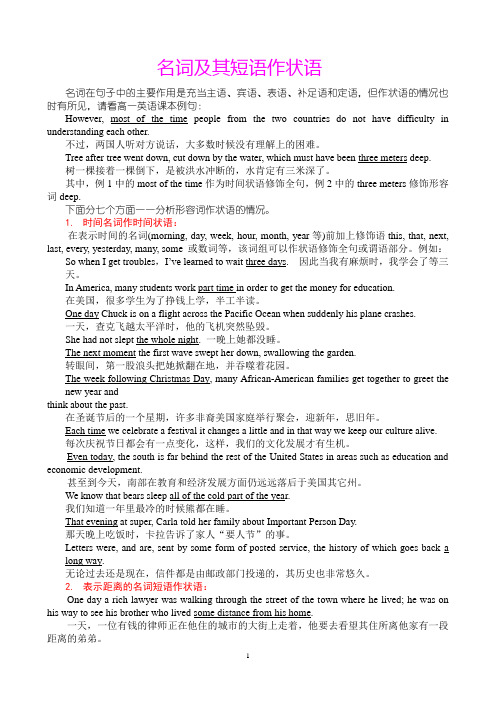
名词及其短语作状语名词在句子中的主要作用是充当主语、宾语、表语、补足语和定语,但作状语的情况也时有所见,请看高一英语课本例句:However, most of the time people from the two countries do not have difficulty in understanding each other.不过,两国人听对方说话,大多数时候没有理解上的困难。
Tree after tree went down, cut down by the water, which must have been three meters deep.树一棵接着一棵倒下,是被洪水冲断的,水肯定有三米深了。
其中,例1中的most of the time作为时间状语修饰全句,例2中的three meters修饰形容词deep.下面分七个方面一一分析形容词作状语的情况。
1.时间名词作时间状语:在表示时间的名词(morning, day, week, hour, month, year等)前加上修饰语this, that, next, last, every, yesterday, many, some 或数词等,该词组可以作状语修饰全句或谓语部分。
例如:So when I get troubles,I’ve learned to wait three days. 因此当我有麻烦时,我学会了等三天。
In America, many students work part time in order to get the money for education.在美国,很多学生为了挣钱上学,半工半读。
One day Chuck is on a flight across the Pacific Ocean when suddenly his plane crashes.一天,查克飞越太平洋时,他的飞机突然坠毁。
名词用作状语的常见类型
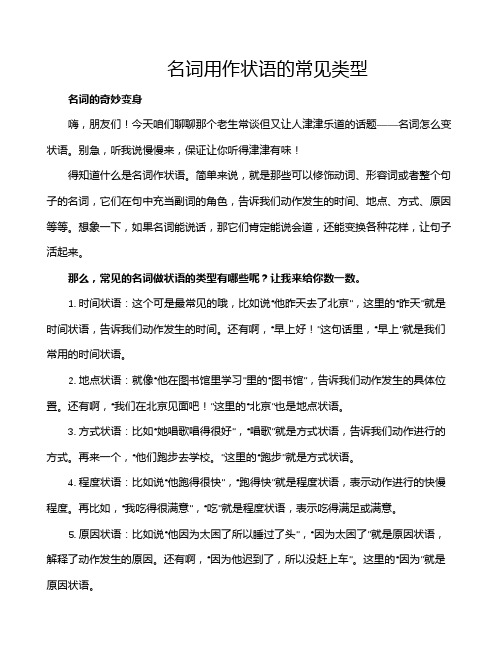
名词用作状语的常见类型名词的奇妙变身嗨,朋友们!今天咱们聊聊那个老生常谈但又让人津津乐道的话题——名词怎么变状语。
别急,听我说慢慢来,保证让你听得津津有味!得知道什么是名词作状语。
简单来说,就是那些可以修饰动词、形容词或者整个句子的名词,它们在句中充当副词的角色,告诉我们动作发生的时间、地点、方式、原因等等。
想象一下,如果名词能说话,那它们肯定能说会道,还能变换各种花样,让句子活起来。
那么,常见的名词做状语的类型有哪些呢?让我来给你数一数。
1. 时间状语:这个可是最常见的哦,比如说“他昨天去了北京”,这里的“昨天”就是时间状语,告诉我们动作发生的时间。
还有啊,“早上好!”这句话里,“早上”就是我们常用的时间状语。
2. 地点状语:就像“他在图书馆里学习”里的“图书馆”,告诉我们动作发生的具体位置。
还有啊,“我们在北京见面吧!”这里的“北京”也是地点状语。
3. 方式状语:比如“她唱歌唱得很好”,“唱歌”就是方式状语,告诉我们动作进行的方式。
再来一个,“他们跑步去学校。
”这里的“跑步”就是方式状语。
4. 程度状语:比如说“他跑得很快”,“跑得快”就是程度状语,表示动作进行的快慢程度。
再比如,“我吃得很满意”,“吃”就是程度状语,表示吃得满足或满意。
5. 原因状语:比如说“他因为太困了所以睡过了头”,“因为太困了”就是原因状语,解释了动作发生的原因。
还有啊,“因为他迟到了,所以没赶上车”。
这里的“因为”就是原因状语。
6. 目的状语:比如说“她想成为一名作家”,“想成为作家”就是目的状语,说明了为什么要做某件事。
再来一个,“他为了救朋友而跳河”。
这里的“为了救朋友”就是目的状语。
7. 比较状语:比如说“他比我高”,这里的“比”就是一个比较状语,用来比较两个事物之间的相对关系。
还有啊,“她比他更漂亮”,这里的“更”就是比较状语,用来表示程度上的比较。
8. 结果状语:比如说“他终于找到了答案”,“找到答案”就是结果状语,告诉我们动作的结果是什么。
名词状语知识点总结

名词状语知识点总结一、名词状语的定义名词状语是指在句子中充当状语的名词或名词短语。
它用来修饰动词、形容词、副词,用以说明动作的时间、地点、原因、目的、结果等。
二、名词状语的种类1.时间状语时间状语是指用来表示动作的发生时间或持续时间的名词或名词短语。
常见的时间状语有:今天、昨天、明天、年、月、日、早晨、上午、下午、晚上、时候等。
例如:他昨天去了图书馆。
(时间状语修饰动词去)我每天都练习钢琴。
(时间状语修饰副词都)2.地点状语地点状语是指用来表示动作发生的地点或范围的名词或名词短语。
常见的地点状语有:家里、学校、公园、办公室、餐厅、城市、国家等。
例如:他在图书馆读了一整天的书。
(地点状语修饰动词读)我们在海边玩了一整天。
(地点状语修饰动词玩)3.原因状语原因状语是指用来表示动作发生的原因或理由的名词或名词短语。
常见的原因状语有:因为、由于、由此、所以等。
例如:他因为生病所以没来上课。
我由于交通堵塞所以迟到了。
4.目的状语目的状语是指用来表示动作的目的或意图的名词或名词短语。
常见的目的状语有:为了、以便、以及等。
例如:他为了省钱买了一辆二手车。
我去超市买东西以便做晚饭。
5.结果状语结果状语是指用来表示动作的结果或后果的名词或名词短语。
常见的结果状语有:因此、所以、由此等。
例如:他学习刻苦,所以考试成绩很好。
她工作认真负责,由此得到了同事们的赞扬。
2019英语名词作状语的结构及其用法语文

英语名词作状语的结构及其用法在英语句子中,状语通常由副词或介词短语来充任。
名词主要用作主语、宾语和表语等句子成分,其作状语直接修饰动词、副词、形容词等的用法经常被忽略。
其实在英语的实际使用中,名词作状语很普遍。
尤其是在现代英语口语中,名词作状语这一现象屡见不鲜。
而大凡语法书对此谈得很少,甚至只字未提。
笔者在此就英语名词作状语的结构及其用法作一肤浅归纳,以期对英语学习者有所帮助。
一、名词作状语的结构1. 名词+s该结构中的名词主要是表示“时间”意义的名词,加上s 后在句中作状语,有些词典因而把这类名词看作副词。
如:hours, mornings, afternoons, eve nings,ni ghts, weeke nds, Mon days, Tuesday 等。
这类名词主要用于美国英语。
例如:We have been sitting here hours waiting for you.We worked nights at that time.Tuesdays I usually go to the library to read some magazines.I haven “ t so much to do eveninagnsd weekends.2. 不定冠词+名词该结构有时表达程度轻、数量少、时间短。
例如:I hardly slept a wink last night.昨天晚上我连眼都没合。
Wait a minute, please!3. 不定代词+名词不定代词some, any, all, another等加上一些表时间意义或行为方法的名词,通常在句中直接作状语。
例如:He has waited some time.I will stay another five months.It may start raining any moment.Do it any way you like.4. 指示代词+名词该结构构成的名词短语通常在句中充任状语。
高考英语语法必考考点(12)状语从句(含解析)
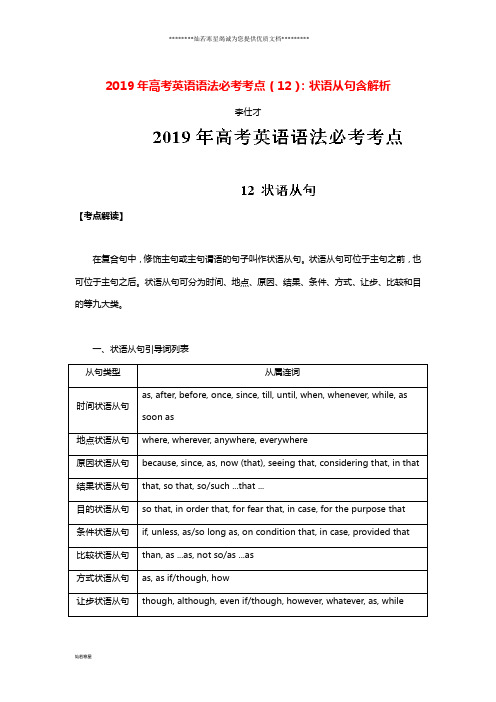
2019年高考英语语法必考考点(12):状语从句含解析李仕才【考点解读】在复合句中,修饰主句或主句谓语的句子叫作状语从句。
状语从句可位于主句之前,也可位于主句之后。
状语从句可分为时间、地点、原因、结果、条件、方式、让步、比较和目的等九大类。
一、状语从句引导词列表从句类型从属连词时间状语从句as, after, before, once, since, till, until, when, whenever, while, as soon as地点状语从句where, wherever, anywhere, everywhere原因状语从句because, since, as, now (that), seeing that, considering that, in that 结果状语从句that, so that, so/such ...that ...目的状语从句so that, in order that, for fear that, in case, for the purpose that条件状语从句if, unless, as/so long as, on condition that, in case, provided that 比较状语从句than, as ...as, not so/as ...as方式状语从句as, as if/though, how让步状语从句though, although, even if/though, however, whatever, as, while【点睛】(1)上述有些连词除了能引导状语从句外,还可引导定语从句和名词性从句。
在使用的时候,要根据句子结构和句意来判别和区分不同的从句,正确使用引导词。
以where为例,试比较下列多种从句的区别。
You are to find it where you left it. (地点状语从句)Tell me the address where he lives. (定语从句,先行词为the address)I don’t know where he came from. (宾语从句)Where he has gone is not known yet. (主语从句)This place is where they once hid. (表语从句)(2)在两个分句间要有一个且只有一个连词,千万不能按汉语习惯。
名词做状语知识点总结

名词做状语知识点总结一、名词做状语的用法名词做状语主要有以下几种用法:1. 表示时间:名词可以表示动作发生的时间、频率或者延续的时间。
比如:- She goes to the gym twice a week.(她每周去两次健身房。
)- I met her last night.(昨晚我见到了她。
)2. 表示地点:名词可以表示动作发生的地点或者场所。
比如:- He works in the office.(他在办公室工作。
)- They are playing in the garden.(他们在花园里玩。
)3. 表示原因:名词可以表示动作发生的原因或者目的。
比如:- He went to the hospital for a check-up.(他去医院做了一次检查。
)- She went to the supermarket to buy some food.(她去超市买了一些食物。
)4. 表示方式:名词可以表示动作的方式或者手段。
比如:- They traveled by train.(他们乘火车旅行。
)- He solved the problem with a computer.(他用电脑解决了问题。
)5. 表示条件:名词可以表示动作发生的条件或者情况。
比如:- I will go to the party with a friend.(我会和朋友一起去参加聚会。
)- He will go to school by bus.(他将乘公交车去上学。
)二、名词做状语的形式名词做状语的形式主要有以下几种:1. 单数名词:单数名词可以简单地表示时间、地点、原因、方式和条件。
比如:- He works on Sunday.(他星期天工作。
)- She lives in New York.(她住在纽约。
)- I study English for my job.(我为了工作学习英语。
)2. 复数名词:复数名词通常用来表示时间、地点、原因、方式和条件。
2019高考英语:(01)二轮语法学案(状语从句)(练习题配解析或解析)

2019高考英语:(01)二轮语法学案(状语从句)(练习题配解析或解析)本单元的语法重点为状语从句状语从句可分为时间、地点、目的、原因、结果、行为方式、条件、让步、比较九种。
引导这些状语从句的连词主要有:ltislongbefore…(过了好久才……〕ltisnotlongbefore…(过了不久就……)2、till与until(till一般不放在句首)(1)持续性动词(肯定式)+until(直到……为止)(2)瞬间动词(否定式)上until(直到……才)(3)强调句型:Itisnotuntil…that…eg:Iwaiteduntil(till)hehadfinishedhiswork、我一直等到他完成工作。
FIedidn'tgotobeduntil/till1cameback、直到我回来、他才去睡觉。
ItWasnotuntillcamebackthathcwenttobeD、直到我回来、他才去睡觉。
3、since意为“自从……以来”。
since一瞬间动词过去式(从该动作发生时算起)since-一持续性动词的过去式(从该动作结束时算起)eg:Hehasbeenworkingveryhardsinceheenteredthefactory、自从他人厂以来一直努力工作。
4、if与unless都可引导条件状语从句、在许多情况下unless可以与、f…not交换使用。
但在以下情况下不可互换:(1)ifnot引导非真实条件句。
(2)unless从句中可用否定词、在、f…not从句中一般不再用否定词。
eg:I’llgounlessnooneelsedoes、除非没有其他人去我才会去。
5、在so+adj/adv+thatclause中、当把so+adj/adv、部分放在句首时、该句主句应为倒装语序。
eg:Sorapidlydid11cspeakthatwecouldhardlyunderstandhimclearly、他讲得太快、我们很难听懂。
英语名词做状语
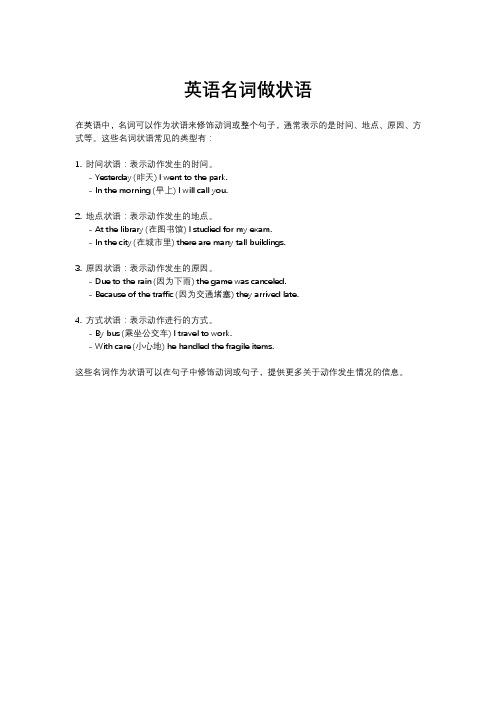
英语名词做状语
在英语中,名词可以作为状语来修饰动词或整个句子,通常表示的是时间、地点、原因、方式等。
这些名词状语常见的类型有:
1. 时间状语:表示动作发生的时间。
- Yesterday (昨天) I went to the park.
- In the morning (早上) I will call you.
2. 地点状语:表示动作发生的地点。
- At the library (在图书馆) I studied for my exam.
- In the city (在城市里) there are many tall buildings.
3. 原因状语:表示动作发生的原因。
- Due to the rain (因为下雨) the game was canceled.
- Because of the traffic (因为交通堵塞) they arrived late.
4. 方式状语:表示动作进行的方式。
- By bus (乘坐公交车) I travel to work.
- With care (小心地) he handled the fragile items.
这些名词作为状语可以在句子中修饰动词或句子,提供更多关于动作发生情况的信息。
2019高考英语三大从句名词性从句定语从句和状语从句详解
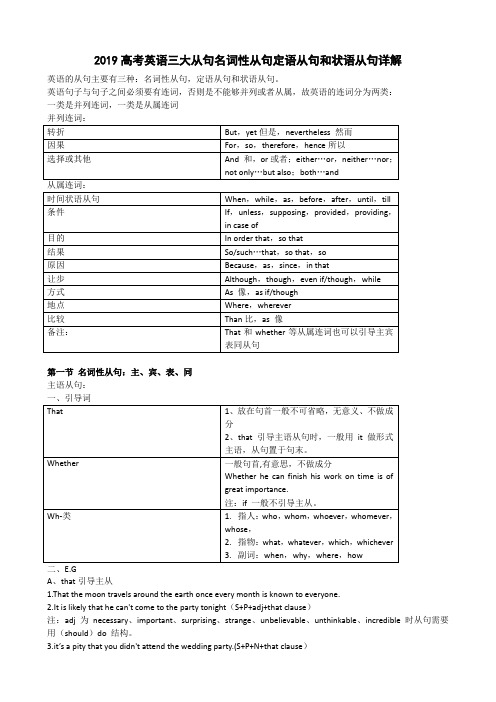
2019高考英语三大从句名词性从句定语从句和状语从句详解英语的从句主要有三种:名词性从句,定语从句和状语从句。
英语句子与句子之间必须要有连词,否则是不能够并列或者从属,故英语的连词分为两类:一类是并列连词,一类是从属连词并列连词:第一节名词性从句:主、宾、表、同主语从句:A、that引导主从1.That the moon travels around the earth once every month is known to everyone.2.It is likely that he can't come to the party tonight(S+P+adj+that clause)注:adj 为necessary、important、surprising、strange、unbelievable、unthinkable、incredible 时从句需要用(should)do 结构。
3.it’s a pity that you didn't attend the wedding party.(S+P+N+that clause)4.it is said that he possesses the too much money.(S+P+done that clause)5.it seems to me that you don't like the idea.(it+特殊动词that clause:seem,matter,turn out,happen等)B、指人指物的为连接代词:故在从句中充当:主宾表语成分,部分充当定语成分whose连接副词在从句中充当主要的时间地点原因和方式状语。
宾语从句一、引导词1.That 无意义,不做成分,口语可以省略,if/whether,有意思,不做成分注意,whether…or/or not;和介词后一般不用if 引导2.关系代词(指人,指物)which3.关系副词(时间地点原因方式)4.特殊的宾从:1.大多数及物动词可以带宾从;在一些v+adv结构中也可以如:figure out,work out,find out,point out 等;一些动词短语也可以如make sure that、keep in mind that2.注意:find,feel,think,consider,make,believe,guess,suppose,assume后如果有宾补时,要借助it形式宾语,将that从句后置Appreciate表示hate,like,take,owe,have,take()for granted等和see to留意后如果有宾补时需要借助it 形式宾语,将宾从后置e.g I hate if when that they talk with their mouth full of foodPlease see to it that the door is safely locked before you go注:介词后that 所引导的宾从必须要用it 形式宾语,除“beyond,but,besides,except,save that clause”“除了”和“in that”“因为”。
高考必备语法素材;英语名词作状语

英语名词作状语一.表现形式名词/名词短语作状语时,主要表现为以下几种形式:1.单个名词:It's miles better. 那样好得多。
His wife is bone idle that she does nothing but play cards. 他妻子懒得很,除了打扑克她什么都不干。
2.(副词+)限定词+名词The meeting lasted an hour. 会议开了一个钟头。
Short pleasure, long lament. 痛快一会儿,后悔一辈子。
The February 7th Memory Tower was built in Zhengzhou more than thirty years ago. 二十七纪念塔30多年前于郑州落成。
3.固定短语英语中,有很多以and/or连接名词或其它形式构成的固定短语在句中作状语,如:The defeated troops were attacked back and belly, and force to retreat to an inhabited island. 败军腹背受敌,被迫撤到无人居住的岛上。
He towers head and shoulders above his contemporaries and yet he remains modest. 他在同代人中出类拔萃,然而却很谦虚。
They will fight tooth and nail/claw for the right to vote. 他们将全力争取选举权斗争。
Labour is running neck and neck with the Conservative Party in the polls. 民意测验中工党和保守党难分高下。
She left me bag and baggage. 他拿走所有的东西离开了我。
Make your owe tea, I don't know why I should wait on you hand and foot. 你自己泡茶吧,我不明白为什么我要殷勤的伺候你。
英语中的状语解析

昨天他尽管有病,仍上学去了。
10.比较状语:
Lesson Two is not so difficult as Lesson One.
第二课不像第一课那样难。
四、状语的位置:
一般说来状语在句中的位置比较灵活,它可 以处于句首、句中或句末。
1.状语位于句首:为了强调状语或者为了 使它与上下文紧密衔接,通常把状语放于句 首。
Tomorrow I am going swimming.
明天我要去游泳。
Here in the cinema house,smoking is not allowed.
在电影院这里不准吸烟的。
2.状语位于句中:状语在句中的位置是:
4.分词(或分词短语):
He sat there reading a novel.
他坐在那儿看小说。
The students went away laughing.
学生们笑着走开了。
5.名词:
Wait a moment.
等一会儿。
It can go all day and all night.
我在农村生活时,向农民学到很多东西。
3.目的状语:
They set out early so that they might arrive on time.
他们早点动身,以便准时到达。
4.原因状语:
She will not go home because she has to attend a meeting.
如果没有助动词,状语就位于动词前面。 I often go to see a film.
英语状语的语法归纳

英语状语的语法归纳英语中的状语是用来修饰动词、形容词或副词等词的,那么你掌握了状语的语法知识吗?下面由店铺为大家整理的状语的语法知识,希望大家喜欢!状语的语法知识归纳状语(adverbial)是句子的重要修饰成分。
状语是谓语里的另一个附加成分,它附加在谓语中心语的后面,从情况、时间、处所、方式、条件、对象、肯定、否定、范围和程度等方面对谓语中心进行修饰或限制。
一、副词作状语Don't drive so fast.别开得这么快。
二、介词短语作地点状语We live in Hangzhou.我们住在杭州。
三、名词作状语The meeting lasted an hour.会议开了一个小时。
状语从句的种类1. 时间状语从句常用引导词:when, as, while, as soon as, before, after, since , till, until特殊引导词:the minute, the moment, the second, every time, the day,the instant, immediately , directly, no sooner … than, hardly …when, scarcely … whenI didn’t realize how special my mother was until I became an adult.While John was watching TV, his wife was cooking.The children ran away from the orchard(果园), the momentthey saw the guard.2. 地点状语从句常用引导词:where特殊引导词:wherever, anywhere, everywhereGenerally, air will be heavily polluted where there are factories.Wherever you go, you should work hard.地点状语从句一般由连接副词where, wherever等引导,已经形成了固定的句型,例如:句型1:Where+地点从句,(there)+主句。
名词作状语英语
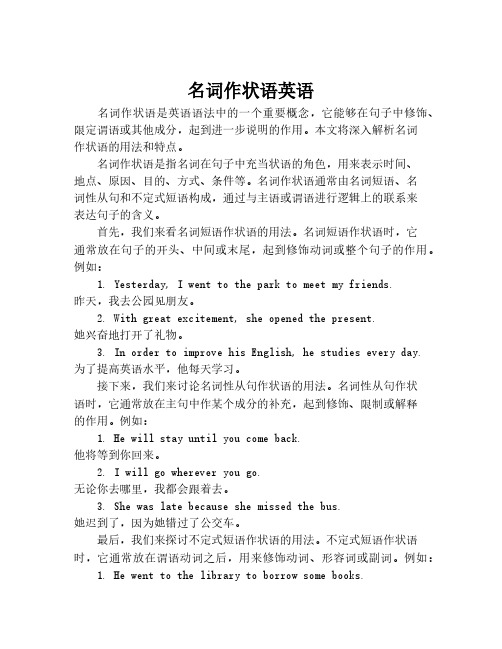
名词作状语英语名词作状语是英语语法中的一个重要概念,它能够在句子中修饰、限定谓语或其他成分,起到进一步说明的作用。
本文将深入解析名词作状语的用法和特点。
名词作状语是指名词在句子中充当状语的角色,用来表示时间、地点、原因、目的、方式、条件等。
名词作状语通常由名词短语、名词性从句和不定式短语构成,通过与主语或谓语进行逻辑上的联系来表达句子的含义。
首先,我们来看名词短语作状语的用法。
名词短语作状语时,它通常放在句子的开头、中间或末尾,起到修饰动词或整个句子的作用。
例如:1. Yesterday, I went to the park to meet my friends.昨天,我去公园见朋友。
2. With great excitement, she opened the present.她兴奋地打开了礼物。
3. In order to improve his English, he studies every day. 为了提高英语水平,他每天学习。
接下来,我们来讨论名词性从句作状语的用法。
名词性从句作状语时,它通常放在主句中作某个成分的补充,起到修饰、限制或解释的作用。
例如:1. He will stay until you come back.他将等到你回来。
2. I will go wherever you go.无论你去哪里,我都会跟着去。
3. She was late because she missed the bus.她迟到了,因为她错过了公交车。
最后,我们来探讨不定式短语作状语的用法。
不定式短语作状语时,它通常放在谓语动词之后,用来修饰动词、形容词或副词。
例如:1. He went to the library to borrow some books.他去图书馆借了一些书。
2. She spoke loudly to be heard by everyone.她大声讲话,为了让大家听到。
语法讲解:名词短语作状语42614教学文稿

语法讲解:名词短语作状语42614语法讲解:名词短语作状语像汉语一样,英语的句子中也有状语,而与汉语不同的是,英语句子中的状语不仅可以修饰谓语动词,还可以修饰作定语或者表语的形容词。
修饰动词、形容词、副词以及全句的句子成份叫状语。
英语句子中的状语,通常是由副词(或相当于副词的词或短语)、介词短语、分词和分词短语、不定式或状语从句充当。
其位置一般放在句末,但也可放在句首或句中。
状语的功用是说明地点、时间、原因、目的、结果、条件、方向、程度、方式和伴随状况等。
在下列几种情况下,名词短语可以充当句子的状语。
一、由表示“平均”、“每一”意义的名词短语充当状语。
1)我们每天六节课:上午四节,下午两节。
We often have six classes every day: four in the morning and two in the afternoon. 2)综英老师要求每个学生每学期至少交四篇作文和一篇调研报告。
The Comprehensive English teacher requests that each student should submit at least fourcompositions and one research report every term.3)每天一个苹果,医生奈我何?An apple a day keeps the doctor away.二、由指示代词“this”、“that”、“these”和“those”修饰的名词短语充当状语。
5) 本学期晚些时候,我们将举行一次英语综合技能大赛。
Later this term, we will organize an English Comprehensive Skills Contest.6) 你这些日子躲到哪里去了?我怎么总看不到你呢?Where have you been all these days? Why haven't I seen you?7) 那天,在回家的路上,我不幸被扒手偷了手机。
名词作状语的两种用法

名词作状语的两种用法
一、名词作状语表示时间
如:Wait a moment. 等一会儿。
See you next week. 下星期见
二、名词作状语表示地点
英语名词有时可用作地点状语,但搭配非常有限,比较常见的用法主要见于以下类似句子:
The Great Wall is world famous. 长城闻名于世界。
The lathe is China made. 这台机床是中国制造的。
三、名词作状语表示距离
名词用作状语表示距离时,主要见于a long way这一结构。
He lives a long way away. 他住得离这里很远。
四、名词作状语表示方式
名词用作状语表示方式时,也主要见于某些特殊搭配。
如:Don't talk to me that way, please.请不要这样同我说话。
Place these tables end to end. 把这些桌子一张接一张地放好
五、名词作状语表示让步
Winter or summer, the sun itself is the same.无论冬夏,太阳本身是一样的。
The sports meet will be held rain or shine. 运动会风雨无阻,照常举行。
英语名词做状语的用法
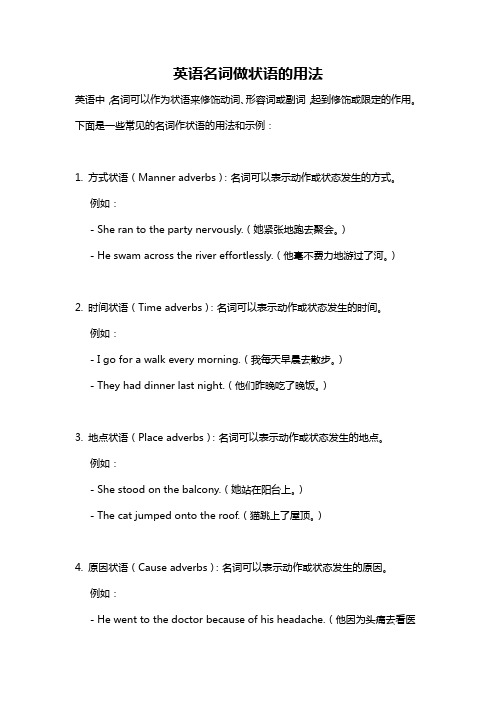
英语名词做状语的用法英语中,名词可以作为状语来修饰动词、形容词或副词,起到修饰或限定的作用。
下面是一些常见的名词作状语的用法和示例:1. 方式状语(Manner adverbs):名词可以表示动作或状态发生的方式。
例如:- She ran to the party nervously.(她紧张地跑去聚会。
)- He swam across the river effortlessly.(他毫不费力地游过了河。
)2. 时间状语(Time adverbs):名词可以表示动作或状态发生的时间。
例如:- I go for a walk every morning.(我每天早晨去散步。
)- They had dinner last night.(他们昨晚吃了晚饭。
)3. 地点状语(Place adverbs):名词可以表示动作或状态发生的地点。
例如:- She stood on the balcony.(她站在阳台上。
)- The cat jumped onto the roof.(猫跳上了屋顶。
)4. 原因状语(Cause adverbs):名词可以表示动作或状态发生的原因。
例如:- He went to the doctor because of his headache.(他因为头痛去看医生。
)- She was upset due to her failure.(她因为失败而心情沮丧。
)5. 目的状语(Purpose adverbs):名词可以表示动作的目的。
例如:- They study hard for good grades.(他们努力学习为了取得好成绩。
)- He exercises daily to stay healthy.(他每天锻炼为了保持健康。
)需要注意的是,根据不同的上下文和语境,名词作为状语时可能带有不同的含义。
因此,在使用名词作状语时,需要根据具体语境来理解其含义。
英语中的状语定义是什么有哪些用法
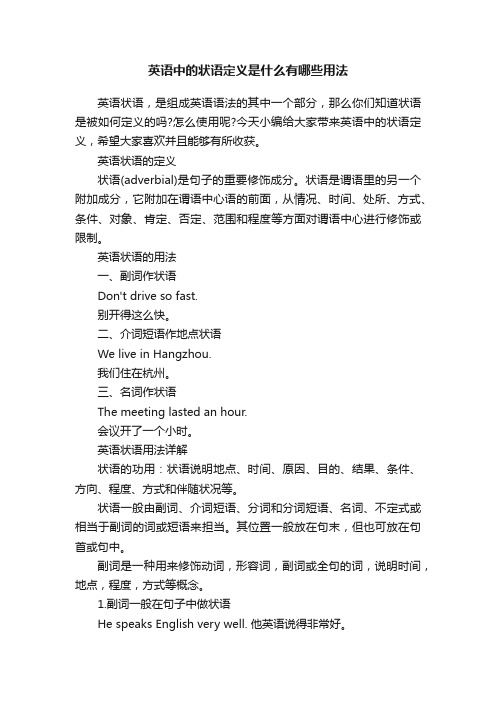
英语中的状语定义是什么有哪些用法英语状语,是组成英语语法的其中一个部分,那么你们知道状语是被如何定义的吗?怎么使用呢?今天小编给大家带来英语中的状语定义,希望大家喜欢并且能够有所收获。
英语状语的定义状语(adverbial)是句子的重要修饰成分。
状语是谓语里的另一个附加成分,它附加在谓语中心语的前面,从情况、时间、处所、方式、条件、对象、肯定、否定、范围和程度等方面对谓语中心进行修饰或限制。
英语状语的用法一、副词作状语Don't drive so fast.别开得这么快。
二、介词短语作地点状语We live in Hangzhou.我们住在杭州。
三、名词作状语The meeting lasted an hour.会议开了一个小时。
英语状语用法详解状语的功用:状语说明地点、时间、原因、目的、结果、条件、方向、程度、方式和伴随状况等。
状语一般由副词、介词短语、分词和分词短语、名词、不定式或相当于副词的词或短语来担当。
其位置一般放在句末,但也可放在句首或句中。
副词是一种用来修饰动词,形容词,副词或全句的词,说明时间,地点,程度,方式等概念。
1.副词一般在句子中做状语He speaks English very well. 他英语说得非常好。
其中的“very”是程度副词,用来修饰“well”。
“very well”是修饰“speak”的程度状语。
2. 不定式在句子中可以作目的状语I come specially to see you. 我专门来看你。
3.介词短语Ten years ago, She began to live in Dalian.从十年以前开始,她开始住在了大连。
The boy was praised for his bravery.这个男孩因为他的勇敢而被夸奖。
4.从句作状语When she was 12 years old, she began to live in Dalian.她12岁的那一年开始居住于大连。
- 1、下载文档前请自行甄别文档内容的完整性,平台不提供额外的编辑、内容补充、找答案等附加服务。
- 2、"仅部分预览"的文档,不可在线预览部分如存在完整性等问题,可反馈申请退款(可完整预览的文档不适用该条件!)。
- 3、如文档侵犯您的权益,请联系客服反馈,我们会尽快为您处理(人工客服工作时间:9:00-18:30)。
英语名词作状语的结构及其用法
在英语句子中,状语通常由副词或介词短语来充任。
名词主要用作主语、宾语和表语等句子成分,其作状语直接修饰动词、副词、形容词等的用法经常被忽略。
其实在英语的实际使用中,名词作状语很普遍。
尤其是在现代英语口语中,名词作状语这一现象屡见不鲜。
而大凡语法书对此谈得很少,甚至只字未提。
笔者在此就英语名词作状语的结构及其用法作一肤浅归纳,以期对英语学习者有所帮助。
一、名词作状语的结构
1.名词+s
该结构中的名词主要是表示“时间”意义的名词,加上s后在句中作状语,有些词典因而把这类名词看作副词。
如:hours, mornings, afternoons,
evenings,nights, weekends, Mondays, Tuesdays等。
这类名词主要用于美国英语。
例如:We have been sitting here hours waiting for you.
We worked nights at that time.
Tuesdays I usually go to the library to read some magazines.
I haven“ t so much to do evenings and weekends.
2.不定冠词+名词
该结构有时表达程度轻、数量少、时间短。
例如:
I hardly slept a wink last night.昨天晚上我连眼都没合。
Wait a minute, please!
3.不定代词+名词
不定代词some, any, all, another等加上一些表时间意义或行为方法的名词,通常在句中直接作状语。
例如:
He has waited some time.
I will stay another five months.
It may start raining any moment.
Do it any way you like.
4.指示代词+名词
该结构构成的名词短语通常在句中充任状语。
例如:
He asked us whether we were going away that day.
We have been discussing the project these days.
I’11 come and see you again this evening.
He has been watching you these ten minutes.
Do it this way.
5.数词+名词
这些名词通常是表示度量或时间的名词。
多数用作程度状语,修饰形容词或副词,也可以修饰动词。
例如:
This desk is two meters long.
I walk three kilometers a day.
The baby weighs nine pounds.
The meeting will last six days.
I’m five years older than his brother.
Why did you come two hours late this morning?
6.形容词+名词。
next,first,last,whole等形容词加上名词可引起该词组的状语化。
例如:
I saw a film yesterday and I“ 11 see another next week.
He went to Shanghai last Monday.
First thing in the morning we swept the courtyard.
We swam the whole day.
7.名词+连词/介词+名词。
以并列连词and或or以及介词by,after,in等连接起来构成不变短语的名词词组通常在句中作状语修饰谓语动词。
多见的有:day after day, night after night, year after year, arm in arm, hand in hand,bit by bit, step by step, part by part, side by side, time and time again, heart and soul,hand and foot, rain or shine等。
例如:
She looked after the child day and night.
They waited on him hand and foot.他们殷勤周到地侍候他。
We should serve the people heart and soul.我们应该全心全意为人民服务。
在这些名词词组里,前后两个名词通常属于同类性质的名词或同一个名词,
如可以是人体某部位或其它同类物体。
这些词组作状语,常放在句尾,具有加强语气的作用。
二、名词作状语的用法
名词作状语时,可在句中修饰谓语动词、形容词、副词以及介词短语等。
1.修饰谓语动词
名词作状语修饰谓语动词时经常置于所修饰的谓语动词之后或句末,当动词是不及物动词时,千万不可把状语看作宾语。
例如:
The meeting lasted an hour.其实这句话应说成:The meeting lasted for an hour.以介词for引导的短语作状语.当介词for省略后,anhour便充任状语修饰谓语动词lasted
2.修饰形容词、副词或介词短语
当名词作状语修饰形容词、副词或介词短语时,常置于这些词之前。
例如:He said it had been completed a year before.
We completed the work five days ahead of time.
The room is three times larger than that one.
3.名词可充任时间、地点、方式、程度、让步等状语。
1)作时间状语。
如:
I ) I shall be back next week.
2) One day a mouse came into the garage and played on the floor.
3) To see once is better than to hear a hundred times.
2)作地点状语。
如:
I ) The swallows go south in winter.
2) She lives next door.
3) We are going some place tonight.
3)作方式状语。
如:
1) Please pronounce the word the way she does.
2) He travels Pullman.他乘软席卧车旅行。
3) Send the letter (by) airmail.
4)作程度状语。
如:
1) He talked a great deal.
2) He is a head taller than his sister.
3) These vases are centuries old.
5)作让步状语。
如:
1) Rain or shine, we have to go.不管天晴还是下雨,我们都得走。
2) He spends an hour a day running, summer or winter.不管是夏天还是冬天,他每天都要花一小时跑步。
总之,英语名词作状语颇为多见,尤其是作形容词修饰语的现象越来越普遍。
将它们用在书面语中可使描写精炼、生动、形象;用在口语中则语气更强,更具有夸张性。
